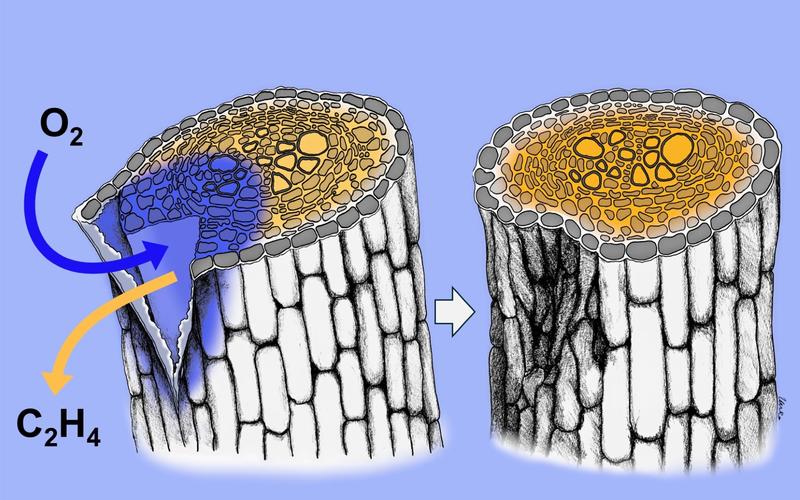Research led by the University of Helsinki, in collaboration with researchers at Oxford Biology, has revealed a key mechanism that plants use to repair their ‘skin’, the periderm. The researchers discovered that the healing process is initiated by diffusion of two gases, ethylene and oxygen, through a wound. The finding has implications for agriculture and food preservation.
All living organisms rely on protective barrier tissues to shield them from the environment. In plants, this role is played by the periderm – the tough outer cork layer that helps prevent water loss and blocks harmful microbes, for example in potato skin and tree bark. But what happens when this protective layer is damaged? A new study using the model plant Arabidopsis thaliana has revealed that plants rely on gas diffusion as a signal to detect injuries and kick-start regeneration.
The research team found that an intact periderm is nearly impermeable to gases, causing ethylene gas, a plant hormone, to build up inside plant tissues while oxygen is depleted during normal growth. When the periderm is wounded, however, the dynamics shift: ethylene escapes and oxygen enters through the injury site. These changes act as warning signals that trigger the plant to begin regenerating the periderm. Once the new barrier is completed, gas diffusion is again restricted. This results in ethylene accumulation and oxygen depletion, signalling that regeneration can stop and normal growth can resume.
Lead scientist Dr Hiroyuki Iida (University of Helsinki) says: “This discovery reveals a beautifully simple, yet effective strategy plants use to monitor damage. Gas diffusion through a wound isn’t just a consequence of injury – it’s the signal that initiates healing.”
Dr Isidro Abreu (Oxford Biology) says:
“This discovery revolutionises the way we think about ethylene. Until now, its accumulation was associated with the healing process. We now show that it is actually ethylene’s release that stimulates wound sealing.”
Dr Vinay Shukla (Oxford Biology) adds:
“So far, reduced oxygen availability has mainly been considered a condition that negatively impacts plant growth. We now show that, in roots and stems, this is actually the norm – and that oxygen influx stimulates wound sealing.”

When a plant is wounded, oxygen moves into and ethylene moves out of the wound, triggering healing.
Image: Alexey Shapiguzov
Better resilience for important crops and longer shelf life for vegetables
The findings have far-reaching implications. Understanding how periderm regeneration is triggered can help improve the resilience of crops like potatoes, carrots, and fruits. Damaged periderm can lead to moisture loss, vulnerability to disease, and ultimately spoilage. By enhancing the plant's natural repair system, scientists could improve crop survival, reduce post-harvest food waste, and help plants better withstand environmental stresses such as drought.
As global food systems face growing pressure from climate change and population growth, this research offers promising new avenues for boosting agricultural sustainability.
Senior author Professor Ari Pekka Mähönen (University of Helsinki) concludes: “Improving the healing capacity of barrier tissues could be a game-changer for food storage and plant resilience.”
To read more about this research, published in Nature, visit: https://www.nature.com/articles/s41586-025-09223-4